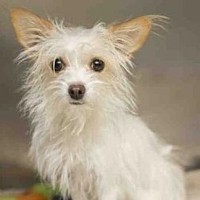Appearance of the Carillon
|
| A Carillon is a small to medium-sized dog with the compact body of a Terrier and the slender features of a Papillon, including slender legs, slightly arched paws and a tapered muzzle. The breed has large, rounded-tipped ears of the drop variety. Carillons' eyes are round and dark, conveying an alert, cheerful expression. Carillons weigh between 5 and 6.5 kilos and measure between 23 and 30.5 centimeters in height. They have a strong, active body with a relatively large rib cage for their size and a medium-length, often feathered tail. Carillons' medium-length coats are straight and thick, and vary considerably in color. They can be various combinations of black, cream, white, silver, gray, red with the possibility of a brindle pattern and black markings, masks and spots. |
Temperament of the Carillon
|
| Carillons retain many desirable qualities from their two parent breeds, and are known as loyal family companions that crave human attention and affection. They are courageous, mischievous animals who like to let off steam indoors with their owners. Chimes inherit the protective instincts of their Terrier lineage, as well as its tendency to bark relatively frequently. This means they can be slightly aggressive towards other dogs and strangers. Note also that Chimes have a strong hunting impulse, so they may chase other small animals when given the chance. As such, introductions to new people and pets should be made with care, and Chimes should be supervised around children. Nevertheless, they are quite friendly with humans and familiar dogs. Because both parent breeds are intelligent, Chimes respond well to obedience training and have a naturally cheerful disposition when in a comfortable environment. They are happiest when at their owner's side, active or snuggling up to them. |
Needs and activities of the Carillon
|
| Carillons are agile, active dogs that require constant, moderate exercise. As they are playful, Carillons are indoor toys and chase balls. They also enjoy a moderate walk or trip to the dog park, depending on how friendly they are with other dogs. Chimes tend to chase other animals and wander, so they should always be supervised in off-leash areas. The size and energy level of Carillons make them suitable for all types of environment - urban, rural, suburban - as long as they get enough exercise. Beyond that, they're well suited to all types of climate. However, like all dogs, they should not be overexercised in hot weather. On the whole, Carillons will be happy and healthy if they lead a decently active life alongside their owner. |
Maintenance of the Carillon
|
| Carillons are not completely hypoallergenic, but produce fewer allergens due to the hair-like coat they inherit from their Papillon parent. They have a low tendency to drool and shed, and do not require intensive grooming. Carillons like to be brushed regularly, which will help keep their coats free of dead hairs. Owners should also consider trimming longer pieces of their coat around the eyes, ears and legs to avoid infections or impediments to mobility. Like all breeds, Carillons need to have their teeth brushed daily and their nails trimmed once or twice a month to avoid painful proliferation or cleavage. |









 English (United Kingdom)
English (United Kingdom)